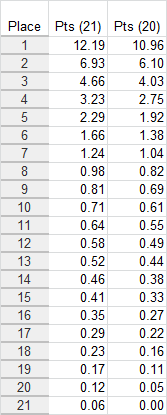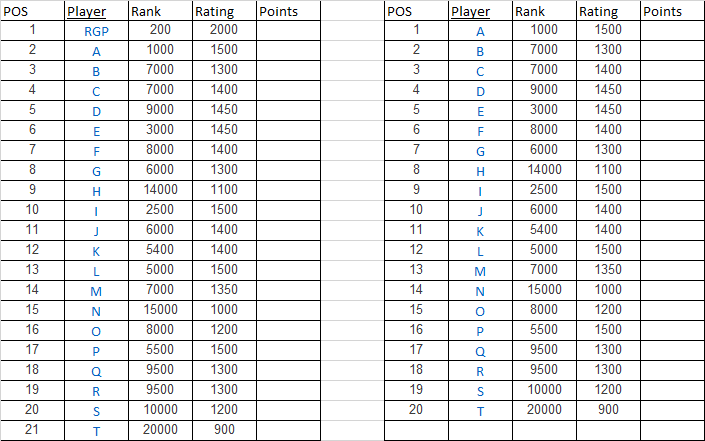General question about IFPA player strength impact to IFPA awarded points:
If there is a player that joins your tournament (say it is a 4 player group matchplay with 20 TGP and 88%) who is miles better than every other player in the tournament, does he/she being a part of the tournament add more points for everyone competing against him/her? Or, is it only the players that finish above the super-good player that get to benefit from the strength that he/she brings to the tournament?
Players add value to the total WPPR points an event is worth. That value is then spread across all the participants that receive points for the event. You don’t have to beat that best player to feast on the value they they bring to the event.
Some average added value figures - actual amount varies with each individual player:
Top 10 player: +1.45
#11-25: +1.11
#26-50: +0.92
#51-100: +0.75
#101-250: +0.54
#251-500: +0.35
#501-1000: +0.16
As to the related question, “Will I get more WPPRs with a visiting top player participating in the event than if they had not,” in most cases, the answer is no unless you do finish ahead of that player. Usually, the WPPR drop-off from position to position is greater than the amount that top player added to the value for finishing in that position.
For fun I ran a simulation of a tournament that would have the highest average WPPRs.
Has the top 64 ranked players
Has the top 64 rated players
Has 128 total rated players.
1st Place: 93.33 WPPRs
Average WPPRs: 11.88 WPPRs
Median WPPRs: 4.71 WPPRs
With Major Bonus Applied:
1st Place: 140 WPPRs
Average WPPRs: 17.82 WPPRs
Median WPPRs: 7.06 WPPRs
Compare this to Pinburgh:
1st Place: 139.91 WPPRs
Average WPPRs: 8.75 WPPRs
Median WPPRs: 6.97 WPPRs
Conclusion: Finish High in Big Events against Good Players for Maximum Points
Top 50 from Simulation points. Place sorted by rank.You might be the one person that we’ve sent our entire database of results to that I thought would/could build a better rankings system ![]()
Dethrone the Swedes! Let’s get WPPR version Tim.Balls.

I’ve stopped worrying about it so much since I’m overranked in the current one
You selfish bastard . . . what about the children? THINK OF THE CHILDREN TIM! ![]()
Tim,
I ran the actuals a year or so ago and got a max of something like 143 and change; it’s posted on here somewhere. Pinburgh is the closest to max we get for total points and for positions other than first place due to the curve; IFPA and PAPA sometimes exceed Pinburgh for first-place points depending upon who attends.
A little trivia: if the current top 14 players played an event, they alone would give it a value of over 25 [26.3] before TGP; the top 30 would be over 50 [51.2 - - 15 for the player count, 36+ for the player value].
The maximum WPPR value of a tournament is going to vary based on what the rating of the top 64 rated players in the world are at that time.
overranked for the win!
Ok thanks for all the feedback. One more hypothetical Q. Say we have a small hypothetical tournament where there are 20 players, all ranked 1000-3000 range (world IFPA ranking). Say a really good player (RGP), ranked 100-200 in the world came and joined. Would the top player get more WPPRs by taking 2nd place to the RGP vs. taking first place if the RGP did not attend?
Bob? ![]()
My guess is winning 1st place if RGP didn’t attend would be worth more. The drop in value between first place and second place can be a pretty significant one with only 20 players competing. Here are a couple of examples:
https://www.ifpapinball.com/tournaments/view.php?t=20632
https://www.ifpapinball.com/tournaments/view.php?t=20236
RGP not showing up removes about 1 WPPR point from the value of the event.
This could be reaching a new level of nerd-dome, but it seems like I am among similar types here. Any way to run your simulation on the following 2 sets of results?
POS Player Rank Rating Points POS Player Rank Rating Points1 RGP 200 2000 1 A 1000 1500
2 A 1000 1500 2 B 7000 1300
3 B 7000 1300 3 C 7000 1400
4 C 7000 1400 4 D 9000 1450
5 D 9000 1450 5 E 3000 1450
6 E 3000 1450 6 F 8000 1400
7 F 8000 1400 7 G 6000 1300
8 G 6000 1300 8 H 14000 1100
9 H 14000 1100 9 I 2500 1500
10 I 2500 1500 10 J 6000 1400
11 J 6000 1400 11 K 5400 1400
12 K 5400 1400 12 L 5000 1500
13 L 5000 1500 13 M 7000 1350
14 M 7000 1350 14 N 15000 1000
15 N 15000 1000 15 O 8000 1200
16 O 8000 1200 16 P 5500 1500
17 P 5500 1500 17 Q 9500 1300
18 Q 9500 1300 18 R 9500 1300
19 R 9500 1300 19 S 10000 1200
20 S 10000 1200 20 T 20000 900
21 T 20000 900
Josh is right. As expected per my observation, the added value is less than the positional drop. Your example’s results are below. In general, the “cost” of adding the high player is less the more people you have in the event. Also note that if the high player finishes 2nd instead of 1st, the winner in this example gets more than a 10% boost to the WPPRs earned.

Ok so looks like Player A in my example above would be better off if the RGP was not there and he/she were able to take 1st instead of 2nd. Very interesting, thank you for sharing…
I remember now that I actually did have a decent idea for rating impact.
The idea would be to simulate the results of events based on the current rating of all the players, so we get an estimate of how often we expect a player to finish higher, lower, or equal to the result they had, and adjust their points according to confidence we had in their rating as well as TGP for impact.
You would have to estimate this by running simulations of events… which would take a long time. I’d have to understand just how few simulations I could get away with to run something like this. Even with something that seems small like 10,000 simulations of every event you’re adding a ton of time to the rebuild process and it doesn’t seem worth going down that path.
The other thing I thought of at the time was building the point distribution up from bottom to top based on the players who finish in this event, but I didn’t like this idea because it made results pretty much linear without me justifying beating Bowden as being 20 times more important than beating Joe Schmoe. Maybe this wouldn’t be as hard as I think using something like rating.
It’s tough to do anything that’s more “accurate” that doesn’t discourage participation or introducing extra potential for collusion.
I’ve been playing with something similar to this idea.
Almost a handicap system.
Every player in the tournament is ranked according to their WPPR pts.
This gives their Tournament Ranking, or expected finishing place as another way of looking at it.
At the end of the competition the difference between their actual finishing position and expected finishing position is determined
It’s nowhere near perfect, and couldn’t be used as an actual ranking, but I think it gives an interesting insight as to how well you performed in any given tournament.
If this system was used exclusively for gaining WPPR pts, it wouldn’t take long before there was a truer reflection of tournament ability / skill etc.
Tournaments could have a multiplier applied, based on the strength of the field participating.
As I say - nowhere near perfect, or even usable, in it’s current state, but could be used as the starting point for something?
(I’m at work and can’t figure out how to share an actual spreadsheet so will have to make do with a screen shot)
